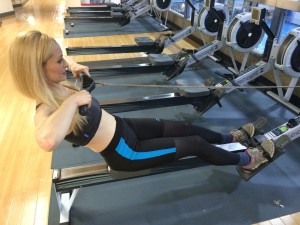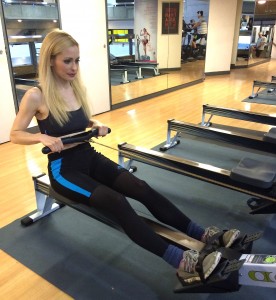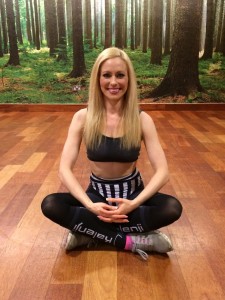I began teaching aerobics after I graduated as a way of keeping fit (and solvent). As a trainee at my local gym, I noticed something that would underpin my entire view of exercise: great technique is everything.
We were blessed with an inspiring and technically brilliant aerobics teacher, whose back-to-back classes lasted for two-and-a-half hours, twice a week. Five challenging hours of sweat and endorphins. (Or, as my Nan put it, “dolphins”). I used to float out of the gym at 9pm feeling like I had won a Greek island.
And it wasn’t just me. There were other devotees, of all ages. The anticipation was like back-stage at Starlight Express rather than two hard-core aerobics classes. It was damn sexy.
The general standard of fitness was high, yet the shapes of the participants varied widely. So I quietly observed them in action to understand why. Unknown factors like diet and genetics aside, I noticed one thing: effort and enthusiasm can only take you so far if you don’t do it right.
This could be for three reasons. Firstly, some people don’t know the correct technique and assume what they’re doing is right. Secondly, what they think they’re doing is copying the instructor but don’t realise that they’re not (time for the old mirror!). Or they might know how to do it properly but either can’t or won’t for their own reasons.
The answer lies in clear instructions, following them, and being prepared to slow down, practise and master the moves before carrying on. Don’t worry about what other people think. It’s your workout, not theirs.
This goes just as much for the instructor as the participants. There is nothing more annoying than trying to follow a new programme when some blousy trainer gallops through it like an X Factor audition and you’re stuck on the first move. Goodbye.
There is also the issue of time. Exercises done in their optimum way means hitting those goals just that little bit quicker, so your time is spent more effectively. Sometimes it’s a case of slowing down to think, and exercising the old grey matter, that produces faster results. Remember the tortoise and the hare.
And do not forget safety. Bad technique can cause short- and long-term injury. Also, by not fulfilling moves to their full potential leads to imbalances in strength, endurance, tone – and overall appearance. You can always spot those who have spent years lifting weights but avoided working their core. Nothing looks stranger than Popeye with a paunch. Nor does it bode well for long-term back health.
Everyone has exercises they love and loathe. Yet by ensuring the technique of both are spot on, and practising a few of the hated moves each session, you could make big improvements in a short time. Even better, you might learn to love those nastier exercises as you can finally see the benefits of doing them properly.

Bad rowing: leaning back, pulling the bar to the chest, raising the cable…could all put strain on the back, waste energy and work the muscles ineffectively
So, let’s start with one piece of equipment where improving the method could make it safer and more effective: the rowing machine.
A favourite of the 1970s, stationary rowing is super non-impact aerobic exercise that works most of the main muscles in the upper and lower body. There are four main positions during rowing: the catch, the drive, the release and the recovery. I just remember the four letters “LAAL”: Legs, Arms, Arms, Legs.
Focusing on this pattern helps keep the back upright, which is key to safe rowing. Swaying backwards and forwards is bad for the back, a waste of energy that could be better used elsewhere, and doesn’t work the muscles most effectively. Remember, the posture is tall like a great oak not swaying like a palm tree!
1. The catch: Ensure you are sitting comfortably, with your feet on the footplate and strapped in at the widest part. Bend the knees, lean forwards and take hold of the bar with a relaxed but firm overhand grip. Your arms should be shoulder-width apart, straight out but slightly bent at the elbow, and the wrists fixed. The lower back should be relaxed and straight. The upper back should lean forwards slightly. The head should face forward in a relaxed position. The knees should be bent and in line with the hips and ankles.

Good rowing: back upright, bar pulled to the abdomen, legs slightly bent, controlled movements to the pattern “legs, arms, arms, legs”
2. The drive: Push with your LEGS, keeping your arms relaxed and almost straight. When the legs are nearly at full stretch, use the ARMS to pull the handle firmly into the abdomen. Keep the legs very slightly bent to avoid injury and keep the back upright. Don’t pull the handle into the chest as you might lean backwards, and damage the back’s ligaments and discs. At the end of the stroke, the upper back should be just past perpendicular, and the legs almost straight. The arms should be pulled in, with the forearms – and cable – nearly horizontal.
3. The release: Allow the ARMS to return to the almost-straight position in a controlled manner, before the LEGS bend, so the handle is forward of the knees. The back should remain upright, with no bending or slumping forward.
4. The recovery: the heels may rise slightly off the footplate as the exercise and momentum take the rower back to the start position. Repeat the entire move.
So remember the pattern: legs, arms, arms, legs. The key to safe and effective rowing.


Comments are closed.